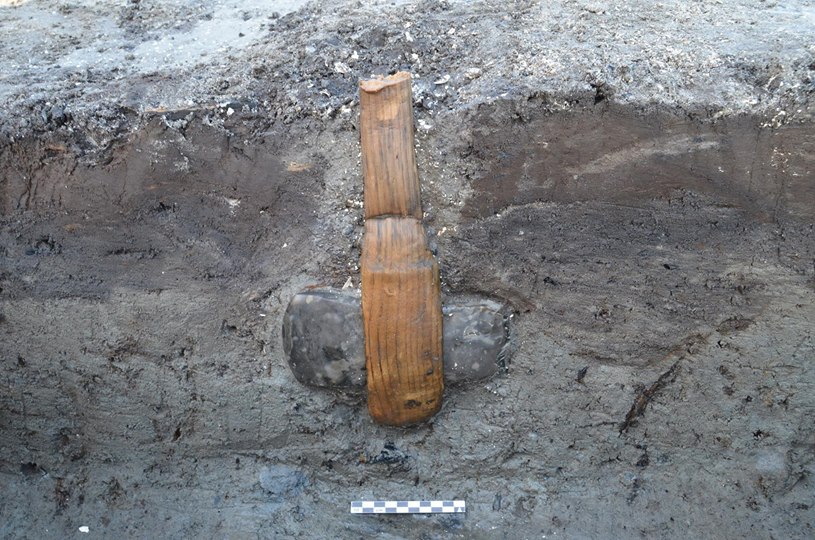
Another fantastic find by archaeologists working on the Fehmarn Belt Tunnel scheme in Denmark. They have uncovered a Neolithic flint axe that is still held within its wooden handle. The axe was discovered within foreshore silts and these damp, relatively anaerobic conditions helped to preserve the organic handle. A number of other artefacts, including wooden paddles, were also identified at this location. Many of of the artefacts appeared to have been deliberately inserted into the seabed in a vertical manner and this has lead to speculation that they may represent some form of ritual activity.
Anker Sørensen, an archaeologist at the Museum Lolland-Falster, conveyed some of the excitement surrounding this site when she stated, ‘finding a hilt axe that is so well preserved is absolutely incredible‘.
Source (in Danish)
Related posts



Any indication as to how it is fixed to the shaft??
I don’t Keith, as far as I’m aware it was was sent straight to the lab for conservation, I’m sure more information will follow shortly
judging by the photo the handle has a carved hole where the stone is inserted. one side of the stone seem smaller.
Was the handle itself shaped with stone tools? If so, how?
Ritually placed. More likely dropped out of boat or from an overturned boat and sank heavy end down.
Very good point! I love how Archaeologists try and say almost everything is ritual.
Ritual was common and frequent. These people lived during an age where surviving to adolescence was a real accomplishment. Risk of death and injury was everywhere. People TODAY still use ritual in even the most mundane of situations–it is something that has never gone away in time, just the reasons have changed.
Yet when an item falls to the bottom of the seabed, they don’t remain suspended upright, they will eventually fall horizontal once the wood becomes waterlogged. It is amazing how much people want to cast doubt into the expertise of others–I wager you’re not an archaeologist, so stop trying to immediately discredit their suggestions. They are the ones who actually know about these kinds of things, and trends in other site finds. There are plenty of reasonable conclusions to suggest ritual activity with deliberate placement/positioning of items, especially during an age where ritual practice was commonplace.
The handle is well shaped and finished. I expected it to be somewhat rough hewn, but it should be no surprise to see Neolithic wood working is as accomplished as their stone work. If only more survived, how enriched our view would be.
Quite alot of wooden artifacts are found in Norwegian sites due to the amount of underwater archaeology that goes on. Almost whole paddles and canoes are found sometimes, the paddles still exhibit designs.
I think I’ve found a stone axe head while digging in Clare, who could I contact about getting it checked?
Hi Joseph you should contact the folks at the National Museum of Ireland